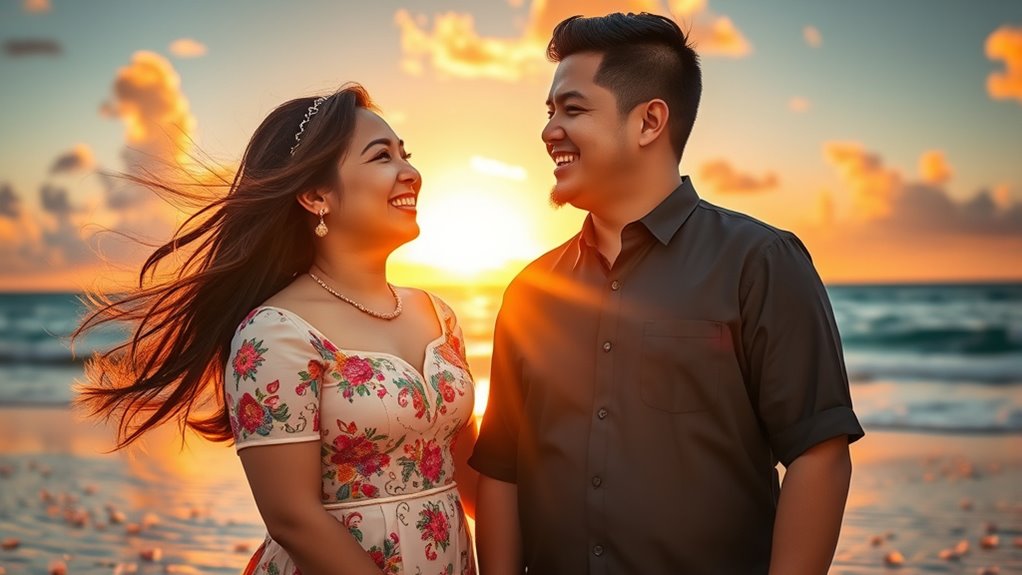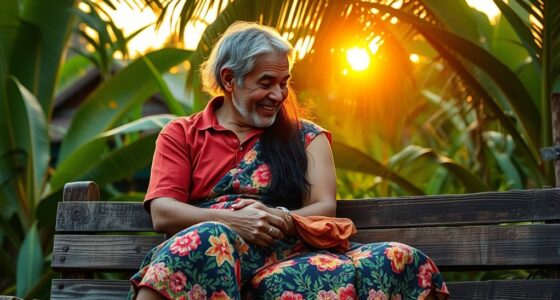Your Filipina marriage is your greatest joy because it seamlessly weaves together rich traditions, family ties, and cultural heritage. Every moment, from the beautiful pamamanhikan to the meaningful rituals, strengthens your bond and connects you to your roots. You experience the warmth of community support and the significance of symbolic customs, enriching your love story. These experiences create a unique foundation for your future together, and there’s so much more to explore about these cherished traditions.
Key Takeaways
- Our union honors rich Filipino traditions, blending cultural heritage with love and commitment, creating a unique and meaningful celebration.
- The strong family and community support enrich our marriage, fostering connections that provide emotional stability and encouragement.
- Pamamanhikan deepened our family ties, allowing us to build a solid foundation of respect and unity before embarking on our journey together.
- Engaging in colorful rituals, such as the unity candle and rice tossing, reinforces our shared values and strengthens our bond with loved ones.
- Our shared commitment to co-parenting and nurturing family connections ensures a loving environment for our future together, enhancing our joy as a couple.
The Beauty of Filipino Wedding Traditions
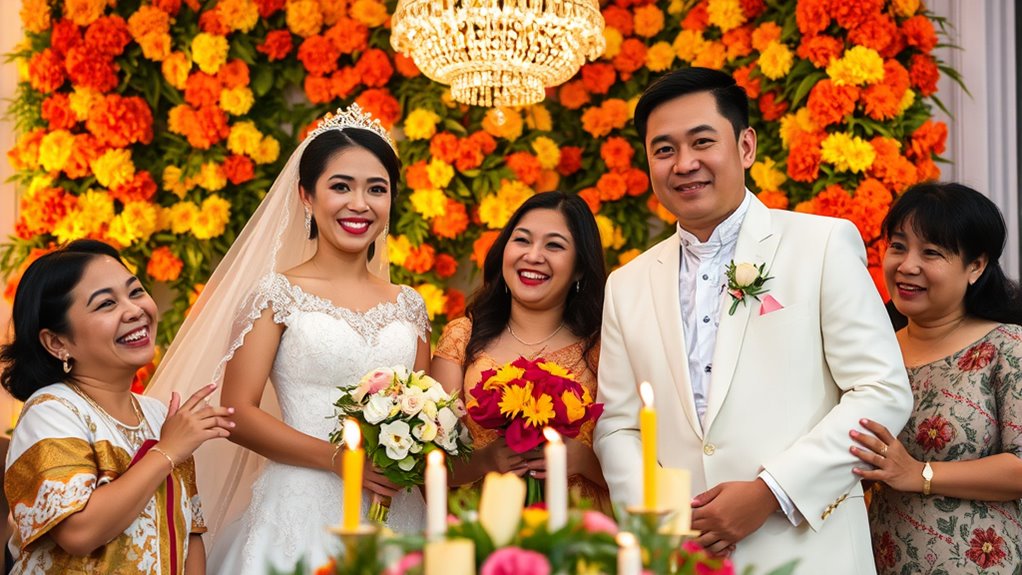
When you explore Filipino wedding traditions, you’ll discover a rich tapestry woven from historical and cultural influences that celebrate love and unity.
These ceremonies, once spanning three days, often feature a *babaylan* officiating, blending indigenous rituals with Catholic elements introduced during Spanish colonialism.
Traditional attire, like the Barong Tagalog for grooms and the Filipiniana for brides, showcases elegance and cultural pride.
Traditional attire, such as the Barong Tagalog and Filipiniana, embodies elegance and a deep sense of cultural pride.
Symbolic items, such as the veil representing unity and the unity cord signifying an eternal bond, enhance the ceremony’s meaning.
The exchange of *arras* reflects the groom’s commitment, while lighting candles symbolizes hope.
These time-honored practices, rooted in heritage, create a memorable experience that honors both love and tradition in every Filipino wedding.
Embracing Family and Community
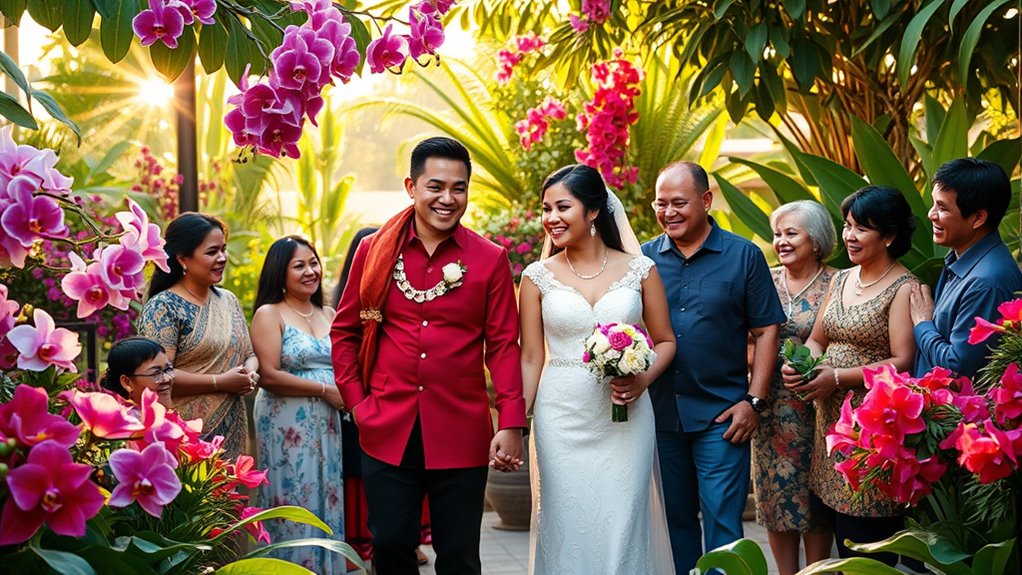
While traversing the complexities of life, embracing family and community is essential to Filipinos, as it fosters a strong support system that nurtures love and connection.
You’ll find that extended family structures, including grandparents and close friends, create a network that provides both emotional and practical support. This unity strengthens family stability, allowing you to navigate life’s challenges together. Additionally, understanding the importance of advance directives can help families make informed decisions about care when needed. Creating a home environment that promotes independence for seniors can further enhance the quality of life for elderly family members. Engaging in pet therapy can also provide companionship and emotional support for both seniors and their families. Furthermore, practicing mindfulness techniques can enhance your self-awareness and improve interpersonal relationships within the family.
Engaging in community activities deepens these ties, enhancing your sense of belonging. Celebrating cultural events and participating in religious activities not only connect you with others but also preserve cherished traditions. Respecting elders and prioritizing education reflect your values, ensuring that family bonds remain strong. In this embrace of family and community, you discover true fulfillment and joy. Professional counseling can also serve as a vital resource for couples seeking to strengthen their relationships amidst challenges.
The Significance of Pamamanhikan
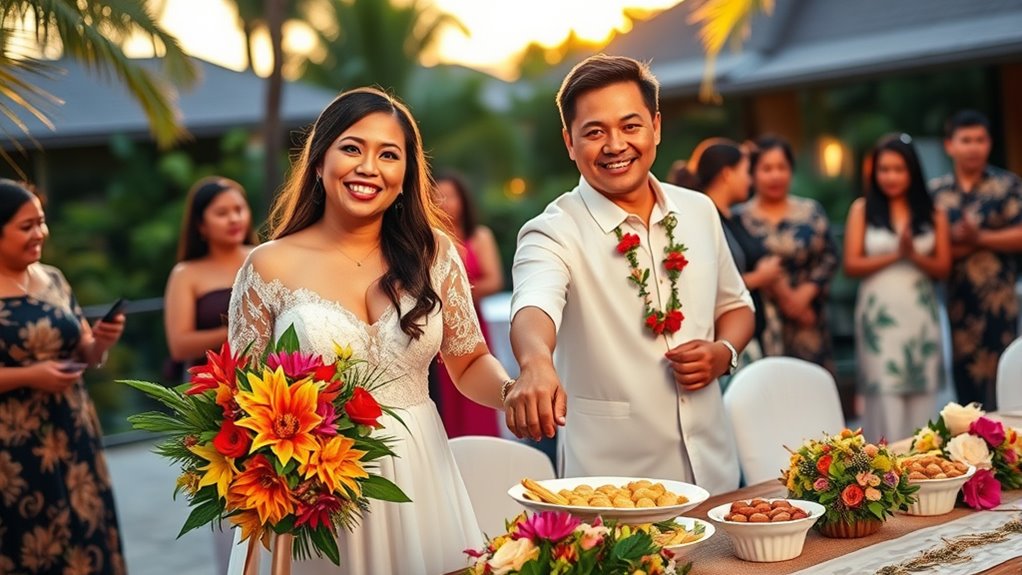
Pamamanhikan stands as an essential tradition in Filipino culture, marking a significant step in the journey toward marriage. This ritual involves the groom’s family visiting the bride’s family to ask for her hand, symbolizing respect and the importance of family bonds.
During this gathering, both families discuss wedding plans, including details like dates and venues, ensuring everyone is on the same page. It also serves as a formal introduction between families, fostering unity and respect. Elders often share wisdom, and the event becomes a celebration filled with food and joy.
While it’s not mandatory, many couples embrace pamamanhikan to honor their heritage and strengthen family ties, making it a cherished part of their journey to marriage.
Rituals That Bind Us Together
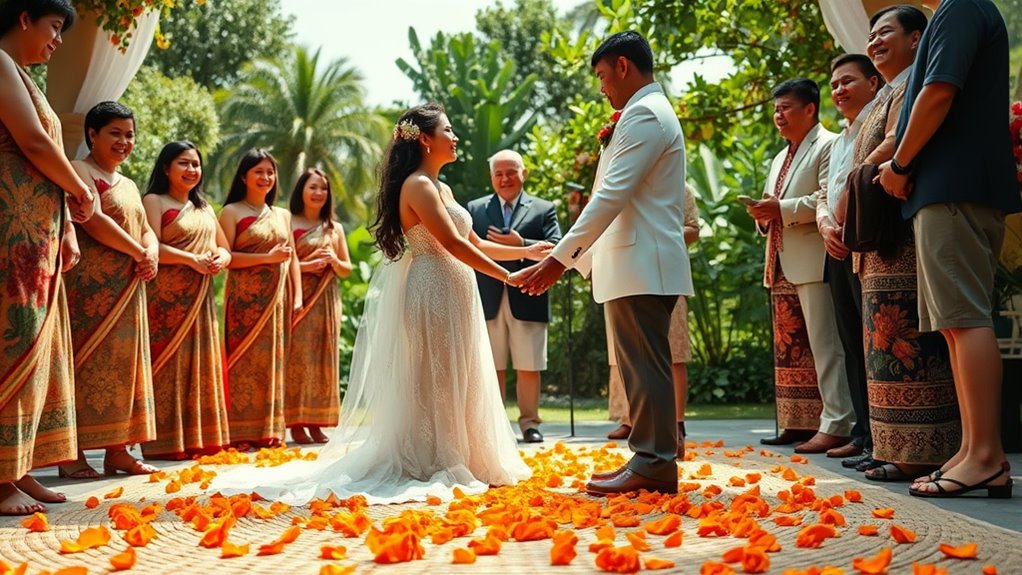
As you explore the rich tapestry of Filipino wedding traditions, you’ll discover that rituals play a vital role in uniting families and celebrating love.
In pre-colonial times, weddings were officiated by a *babaylan*, with the couple’s hands joined over uncooked rice for blessings. Blood mixed with water symbolized their unity, while sharing cooked rice from a single container further cemented their bond.
Spanish colonialism introduced Catholic elements, blending faith with indigenous customs, emphasizing the lifelong commitment of marriage.
Traditional attire, like the Barong Tagalog and Filipiniana, along with symbolic cords and thirteen “arras,” reflect the importance of family and community.
Ultimately, these rituals strengthen connections not just between the couple, but their families, highlighting the deep cultural significance of marriage.
Symbolism in Filipino Wedding Customs
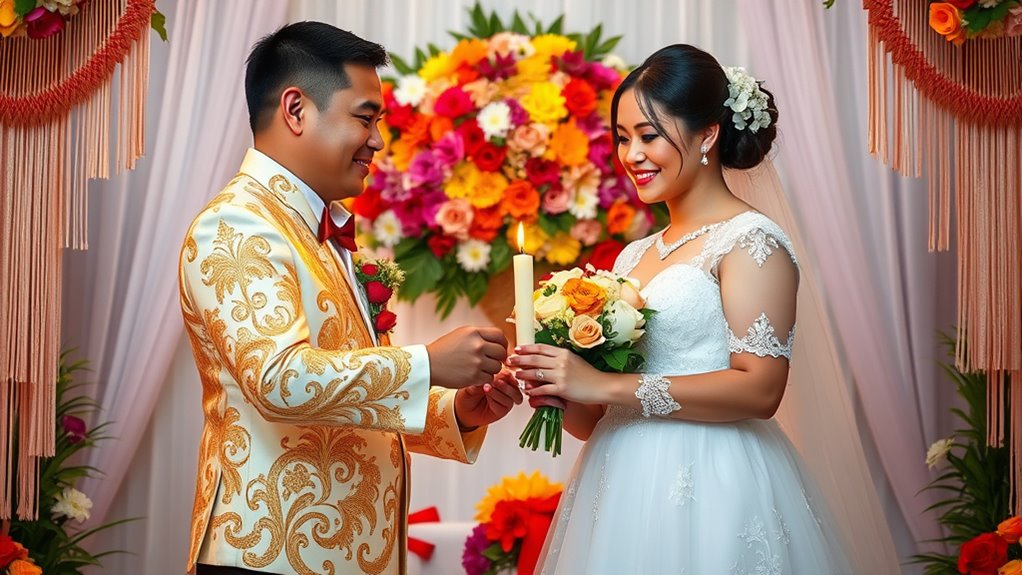
Filipino wedding customs are rich with symbolism that deepens the meaning of the rituals and objects used during the ceremony.
The veil represents unity and protection, while the cord, looped around your shoulders, signifies eternal love and fidelity.
The 13 coins, or Las Arras, embody prosperity and the groom’s commitment to support his bride.
Exchanging wedding rings marks your mutual commitment and love.
The unity candle symbolizes the joining of two families and the presence of God in your union.
These elements reflect a blend of cultural influences, including Spanish and American traditions, enriching your wedding experience while honoring Filipino heritage.
Each symbol adds profound significance, making your celebration even more meaningful.
The Role of Elders in Our Union
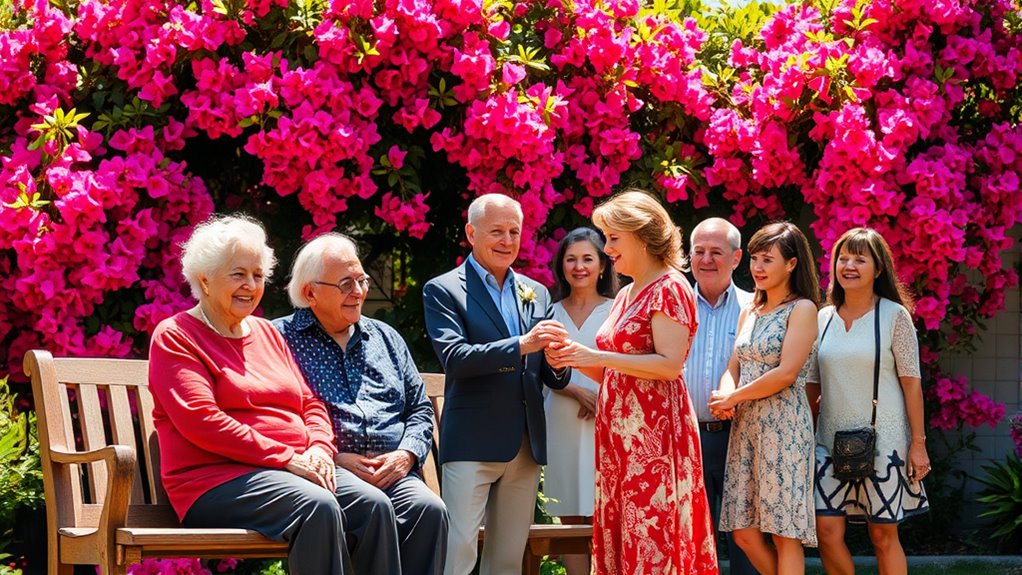
While planning your wedding, the role of elders becomes pivotal in shaping the ceremony and ensuring that cherished traditions are honored. In Filipino culture, seeking the blessings of elders highlights your respect and humility.
They facilitate family ties, reminding you that marriage unites two families, not just two individuals. Elders help preserve cultural traditions and pass them down, ensuring continuity. Their wisdom serves as moral guidance for you and your partner, contributing to a harmonious marriage.
During pre-marriage rituals like *pamamanhikan*, they play essential roles in discussions about wedding details. On your wedding day, their presence brings significance, from offering blessings to participating in rituals, reinforcing their importance in your union and community.
Blending Cultures: Modern and Traditional
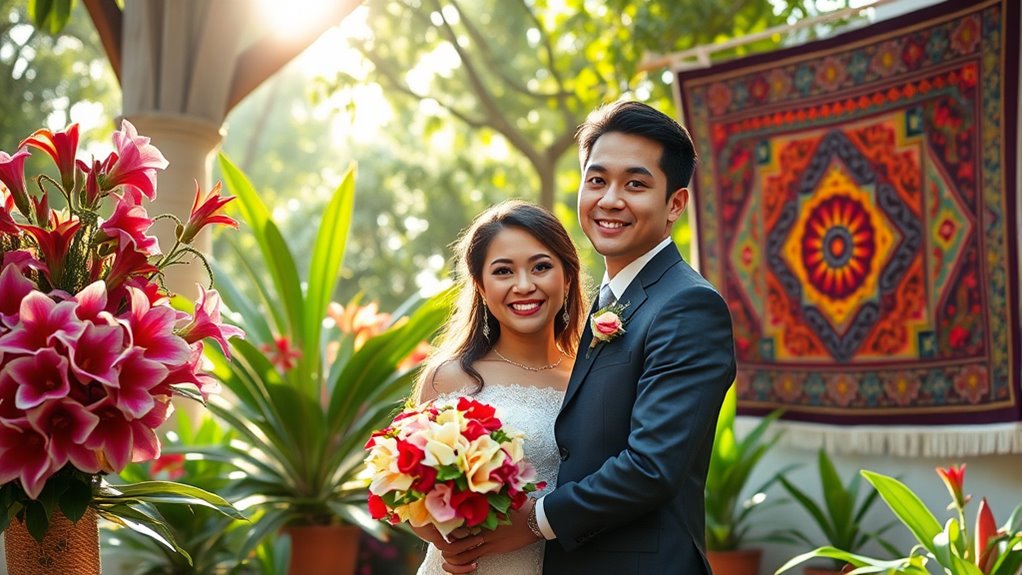
When you plan your wedding, blending modern and traditional elements can create a meaningful celebration that honors your heritage while embracing contemporary influences. Incorporating Western traditions, like the unity candle, alongside Filipino customs, such as the veil and cord ceremony, symbolizes unity and commitment. You might choose to wear a Barong Tagalog or Filipiniana, showcasing your cultural roots. Additionally, creating an interior design mood board can help you envision the aesthetics of your wedding venue, ensuring it reflects both your cultures. Creating seamless indoor-outdoor flow can also enhance the overall ambiance, allowing guests to enjoy both the beauty of nature and the comfort of your venue.
Involving family is essential, as they play significant roles, from secondary sponsors to ring bearers. Modern touches, like fusion food menus and digital documentation, enhance the experience. Additionally, networking seen as essential for expanding your support system can also apply to planning your wedding, helping you connect with vendors and resources that align with your vision. Engaging with practical insights can lead to creative ideas that make your wedding uniquely yours. Furthermore, creating cozy spaces at your venue can enhance the atmosphere, making your celebration warm and inviting for all your guests.
Ultimately, this blend preserves traditions while reflecting your unique journey, fostering a celebration that’s both personal and culturally rich. Embrace the beauty of your diverse backgrounds and let it shine through your wedding.
Superstitions and Their Meaning
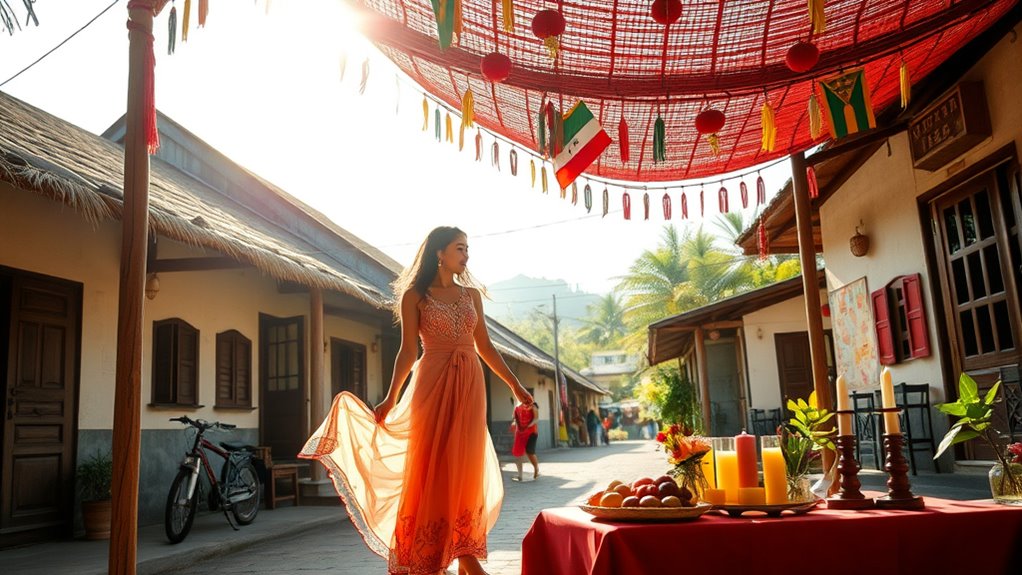
Weddings in the Philippines aren’t just about love and commitment; they’re steeped in rich superstitions that add depth and meaning to the ceremony.
For instance, the belief in *sukob* warns against siblings marrying in the same year to avoid bad luck. You might offer eggs to St. Claire for good weather on your wedding day, while avoiding sharp gifts to prevent symbolizing a broken marriage.
The candle rituals, where sponsors light candles, hint at deeper connections, and tossing rice at the newlyweds represents prosperity. These superstitions reflect a blend of historical beliefs and cultural significance, engaging families and communities while reinforcing hope and positivity around the sacred institution of marriage. Additionally, it’s important to consider how parental infidelity can affect children’s future relationships, highlighting the significance of a stable foundation in marital unions.
A Celebration of Love and Heritage
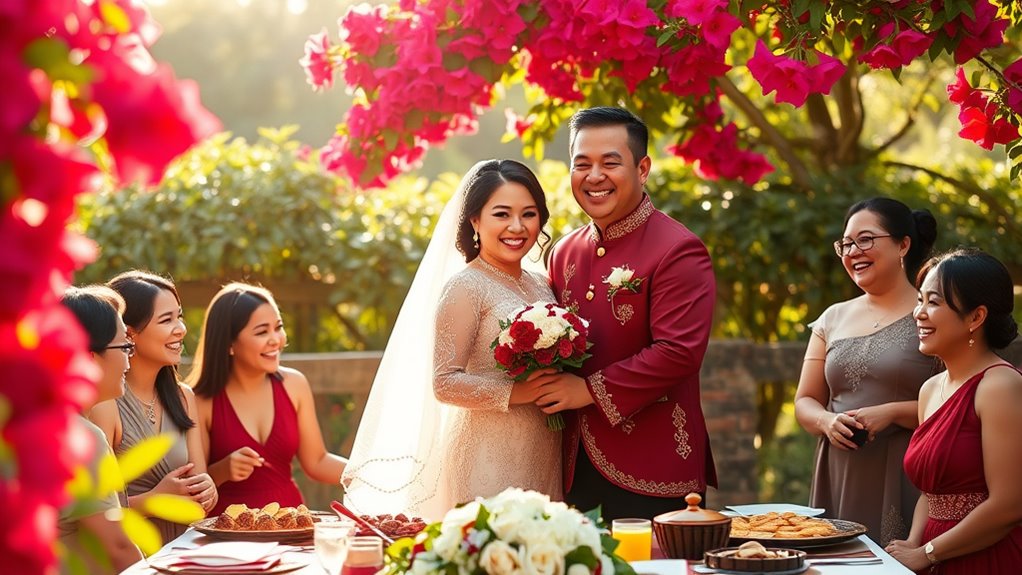
A Filipina marriage isn’t just a union of two people; it’s a vibrant celebration of love, culture, and heritage that brings families and communities together.
From the heartfelt pamamanhikan, where families bond and bless the couple, to the colorful rituals like the unity candle and pangalay dance, each step honors tradition. This celebration often emphasizes the importance of community support as families come together to ensure the couple starts their journey with strength and love. Additionally, this union often reflects the couple’s commitment to successful co-parenting practices that benefit their future family.
The pamamanhikan and vibrant rituals beautifully intertwine family bonds and traditions, celebrating love in every step.
You’ll see the barong Tagalog and terno, beautifully adorned with cultural motifs, symbolizing ancestral pride.
As you partake in the festivities, savor the post-wedding feast, a grand gathering that strengthens family ties.
Even in modern ceremonies, the blend of old and new reflects your unique love story while preserving cherished customs. This celebration isn’t just yours; it’s a tribute to your roots and shared future. Additionally, navigating effective co-parenting is essential for maintaining strong family bonds, especially in blended families.
Frequently Asked Questions
How Do Filipino Wedding Traditions Differ Across Various Regions?
Filipino wedding traditions vary considerably across regions.
In Northern Luzon, you’ll find indigenous textiles and community involvement, while the Visayas focuses on Catholic practices and family unity.
Mindanao showcases a rich blend of Muslim and indigenous customs, incorporating unique rituals like the *Kagen & Taltag*.
If you’re considering an intercultural wedding, you might blend Filipino traditions with those from other cultures, creating a unique celebration that reflects both backgrounds.
What Are the Most Common Wedding Gifts in Filipino Culture?
So, you’re scratching your head over what to gift at a Filipino wedding? Forget the generic toaster—how about a beautifully embroidered Barong Tagalog or some intricate T’nalak?
Practical gifts like kitchen essentials are great, but sentimental items like memory books or love letters really tug at the heartstrings.
Don’t overlook traditional symbols, either; those 13 coins and a looped cord can add a touch of meaningful flair to their new life together!
How Can Couples Incorporate Personal Touches Into Their Filipino Wedding?
You can incorporate personal touches into your Filipino wedding by customizing your attire with family heirlooms or meaningful accessories.
Consider using handcrafted gifts as wedding favors, like woven baskets or personalized abanico fans.
Enhance the atmosphere with a blend of traditional and modern music, and include family photos or cultural artifacts in your decor.
Finally, involve your community and family in planning, creating a deeper connection to your roots and shared experiences.
What Role Do Friends Play in Filipino Wedding Celebrations?
In Filipino wedding celebrations, friends play crucial roles that enhance the experience. You’ll find them acting as bridesmaids and groomsmen, assisting you throughout the day.
They participate in symbolic rituals like the candle, veil, and cord ceremonies, emphasizing community. Friends also help with planning pre-wedding events and providing emotional support, making the celebration more festive and memorable.
Their involvement not only supports you but also highlights the importance of social bonds in Filipino culture.
Are There Specific Dates Considered Auspicious for Filipino Weddings?
Yes, there are specific dates considered auspicious for Filipino weddings. You might choose dates that incorporate numbers like 2 or 8, which are seen as lucky.
January often features popular dates such as the 1st, 2nd, and 3rd. Additionally, many couples consult cultural beliefs and traditions to select their wedding date, ensuring it aligns with positive energies.
Ultimately, picking a date with care can enhance the joy and success of your marriage.
Conclusion
In the tapestry of our lives, your Filipina marriage is a vibrant thread that weaves together love, tradition, and family. Celebrating our union through rituals and customs not only honors our heritage but also strengthens our bond. With every shared moment, you’re reminded that love isn’t just a feeling; it’s a beautiful journey we navigate together. As you embrace these traditions, you’ll find that your hearts truly beat as one, creating a legacy filled with joy.
